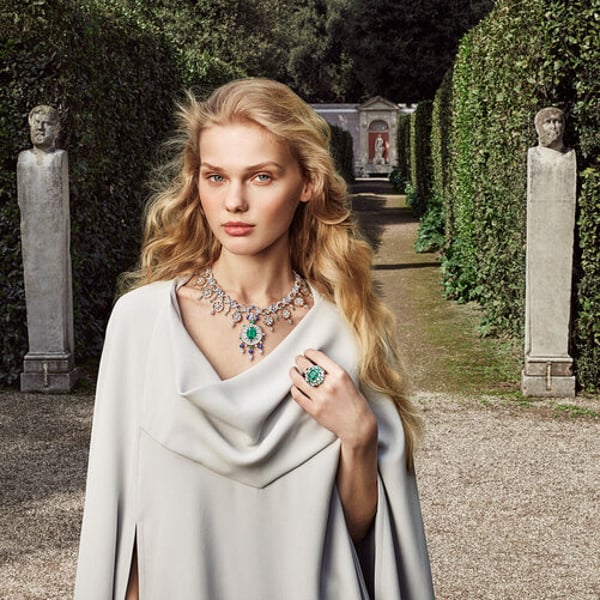
Has Arnault launched the mating dance of the bling kings?
Last Updated on February 2, 2024 by Admin
[ad_1]
By
Bloomberg
Published
Feb 1, 2024
The wolf is licking its lips. The prey is not wearing a red hooded cape, but Van Cleef Arpels jewelry.

Bernard Arnault, the founder and chief executive officer of LVMH who’s known as the “wolf in cashmere,” last week sang the praises of Van Cleef owner Cie Financiere Richemont SA, and quipped that if its chairman, Johann Rupert, wanted “support to maintain his independence, I’ll be there.”
It was an odd thing to say, and it’s not clear what Arnault meant. Maybe it was a joke, but it raises questions about Richemont’s status — whether it needs a partner, and what exactly Arnault might get out of such a show of solidarity. Not surprisingly, the comment, on LVMH’s earnings call last week, reignited speculation that he has his sights on acquiring Richemont. If so, the tricky part will be persuading Rupert that he needs any help at all.
A combination of LVMH Moët Hennessy Louis Vuitton SE and Richemont would certainly be compelling. It would create a jewelry powerhouse — bringing together Tiffany, which joined the Arnault stable three years ago, and sister house Bulgari, with Van Cleef and Cartier, another Richemont property enjoying a surge in popularity. Add in LVMH’s Louis Vuitton, the world’s biggest luxury brand, as well as its smaller Dior, and LVMH would be in a completely different stratosphere.
And LVMH can afford it. Assuming the standard 30% takeover premium, Richemont would be valued at about at 100 billion Swiss francs ($116 billion). An all-cash deal might be a stretch, but it could raise funds by selling assets, such as a stake in its wines and spirits division to partner Diageo Plc, or via a listing. The whole of the drinks business could have an enterprise value of about €30 billion ($32 billion). LVMH could use a mixture of cash and shares. (We’ll skip the issue of competition concerns for the purpose of this exercise).

The main snag would be that Rupert has made it very clear that Richemont is not for sale: He said in May that he’d decided against a deal with rival Kering SA two years earlier, when investment bankers proposed one. And he will determine Richemont’s fate, because he has about 10% of the equity and 51% of the voting rights.
Richemont needs no support from Arnault right now. Two weeks ago, it reported better-than-expected sales, thanks to sparkling jewelry demand. One thesis among investors is that given the aggressive price increases in handbags over the past three years, jewelry is now a better value to top-end shoppers. Richemont also has a strong balance sheet, with net cash of €6.8 billion at the end of December.
There is one area where LVMH could help: Taking Yoox–Net-a-Porter off of Richemont’s hands, after a deal to sell a stake to Farfetch Ltd. fell through. That would certainly benefit Richemont’s standalone investment story, but it’s not clear what it would do for LVMH.
Like LVMH, Richemont will eventually have to face Rupert’s succession. Both he and Arnault are in their 70s. Richemont already has an external CEO, Jerome Lambert, and Cyrille Vigneron, head of Cartier, is another powerful executive. Rupert’s son Anton is also on the board. But Rupert as chairman and controlling shareholder is at the center of it all. It’s not clear from the outside how the patriarch might step back if he wanted to. As the world is transfixed on the transition to the next generation at LVMH, the issue will come into sharper relief at Richemont too.
Could Rupert be persuaded to entrust the company to LVMH, where it could be nurtured for the long term as one of a stable of top brands managed by the undisputed industry leader? If so, the Rupert family would have to share in the upside.

Perhaps an alliance involving LVMH taking a minority stake might be the first step. A precedent could already have been set by the transaction that LVMH’s great rival, Kering, struck last year to acquire a 30% stake in Valentino, with the option to buy 100% at a later date.
LVMH usually prefers majority deals, although it has had a longstanding minority holding in Tod’s SpA. But Arnault may be prepared to make an exception for Richemont, because in luxury, once you lose out on a prized asset, it is usually gone forever. There may be another reason: Kering, which I have long argued is the better partner for Richemont, would struggle to make a move right now. The company has its hands full, trying to revitalize Gucci, integrating premium perfume brand Creed and making the most of the Valentino relationship.
If LVMH were to acquire a stake in Richemont, another tricky question would be whether it would prevent the Swiss company entering into another deal. Kering might not be offside forever, and with Richemont’s market value now significantly more than the French company, Rupert would have the upper hand, perhaps making this combination more palatable.
Rupert said in May that he and Arnault were in “constant dialogue and we respect each other’s independence.”
The admiration is mutual. Arnault last week described Rupert as “an outstanding leader, and I don’t in the slightest wish to upset his strategy.”
But that didn’t stop him going a step further. That may be because Rupert rather than Arnault is the luxury kingmaker. If ever he decides to collaborate, and whom he chooses as his partner, will determine the balance of power in the industry. No wonder Arnault wanted to send a message that if and when that time comes, he is ready.
[ad_2]
Source link




